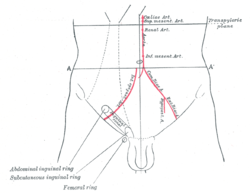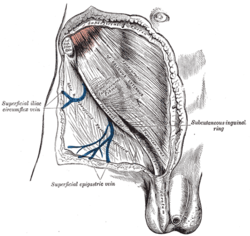- Superficial inguinal ring
-
Superficial inguinal ring 
Front of abdomen, showing surface markings for arteries and inguinal canal. (Subcutaneous inguinal ring labeled at lower left.) 
The subcutaneous inguinal ring. Latin annulus inguinalis superficialis Gray's subject #286 1315 The superficial inguinal ring is an anatomical structure in the anterior wall of the human abdomen. It is a triangular opening that forms the exit of the inguinal canal, which houses the ilioinguinal nerve, the genital branch of the genitofemoral nerve, and the spermatic cord (in men) or the round ligament (in women). At the other end of the canal, the deep inguinal ring forms the entrance.[1] It is also called the subcutaneous inguinal ring or external inguinal ring.
It is found within the aponeurosis of the external oblique, immediately above the crest of the pubis, 1 centimeter above and lateral to the pubic tubercle. It has medial and lateral crura. It is at the layer of the aponeurosis of the obliquus externus abdominis.[2]
Clinical significance
The superficial ring is palpable[3] under normal conditions. It becomes dilated in a condition called athletic pubalgia. Abdominal contents may protrude through the ring in inguinal hernia.
References
External links
- SUNY Labs 35:09-0101 - "Anterior Abdominal Wall: Borders of the Superficial Inguinal Ring"
- SUNY Figs 36:01-13 - "The inguinal canal and derivation of the layers of the spermatic cord."
- 543883342 at GPnotebook
 Diagram of an indirect, scrotal inguinal hernia ( median view from the left). The external inguinal ring is labeled.
Diagram of an indirect, scrotal inguinal hernia ( median view from the left). The external inguinal ring is labeled.
This article was originally based on an entry from a public domain edition of Gray's Anatomy. As such, some of the information contained within it may be outdated.
List of muscles of abdominopelvic cavity (TA A04.5, GA 4.408) Abdomen/
wallAnterior/
lateralMuscleFasciaFascia/abdominal fascia: panniculus adiposus (Fascia of Camper) · stratum membranosum (Fascia of Scarpa) · Transversalis fascia (Interfoveolar ligament)
Linea alba · Linea semilunaris · Inguinal triangle
Inguinal canal (Deep inguinal ring, Superficial inguinal ring, Intercrural fibers, Crura of superficial inguinal ring)
Inguinal ligament (Pectineal ligament, Lacunar ligament, Reflected ligament)PosteriorMuscleFasciaPelvis MuscleFasciafascia/pelvic fascia visceral (Rectovaginal fascia, Rectoprostatic fascia) · parietal (Obturator fascia/Tendinous arch, Piriformis fascia)
floor/diaphragm: Superior fascia of pelvic diaphragm (Pubovesical ligament, Puboprostatic ligament) · Inferior fascia of pelvic diaphragm
Anococcygeal body
This anatomy article is a stub. You can help Wikipedia by expanding it.
